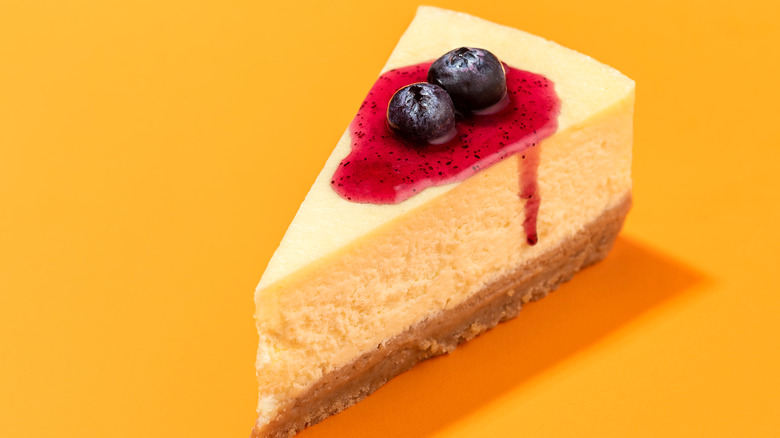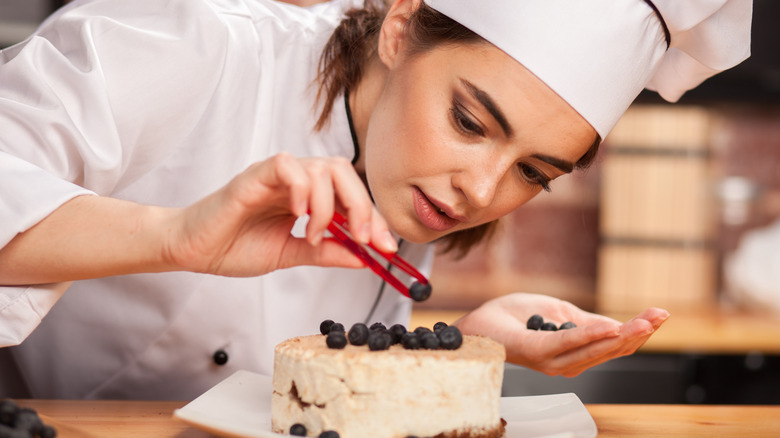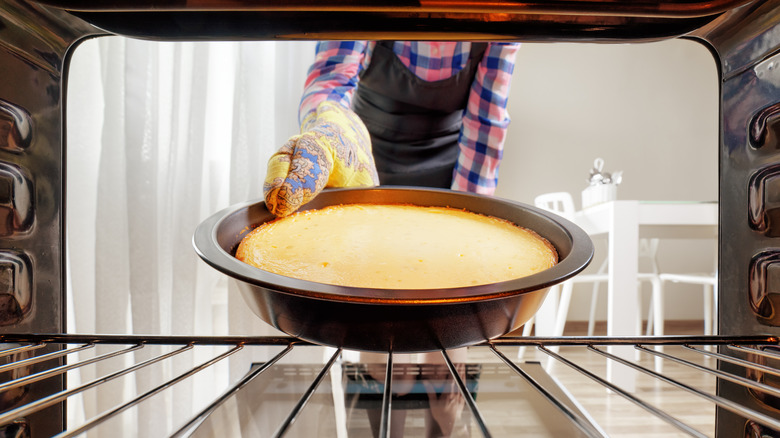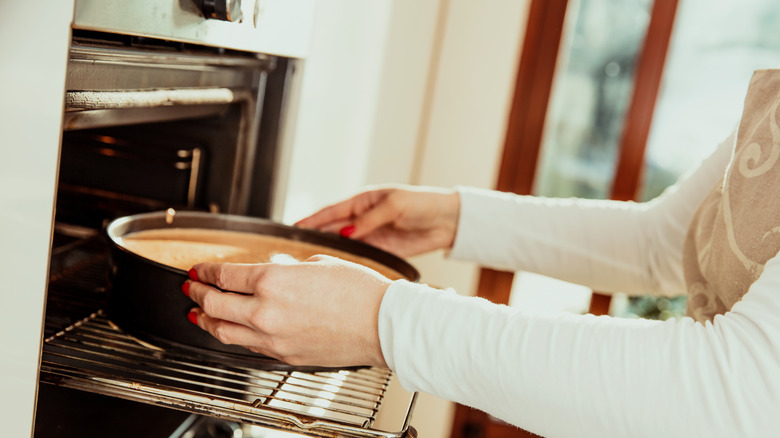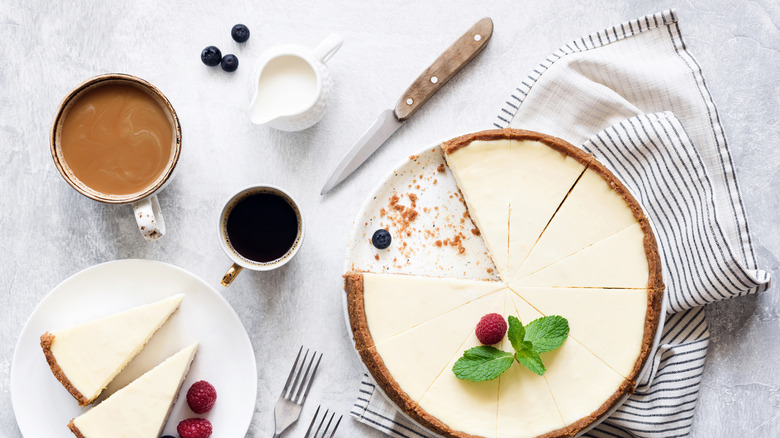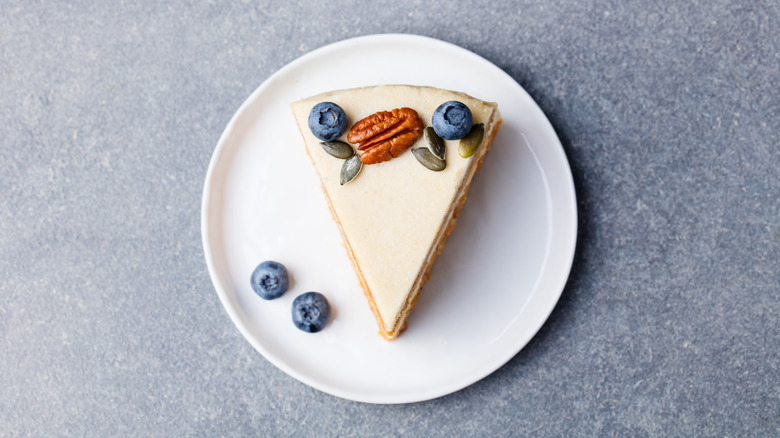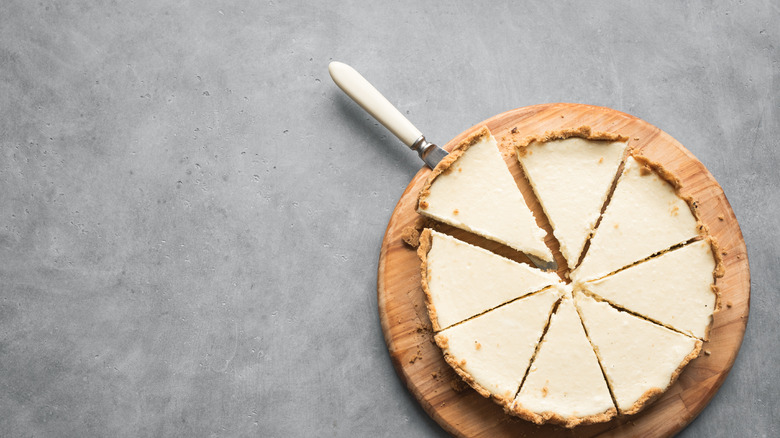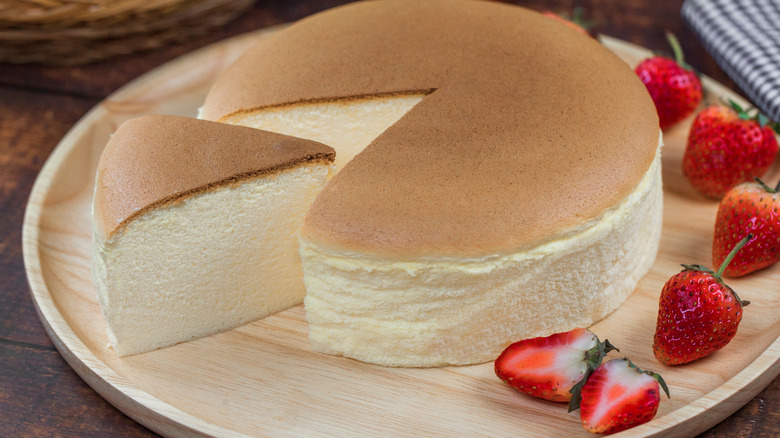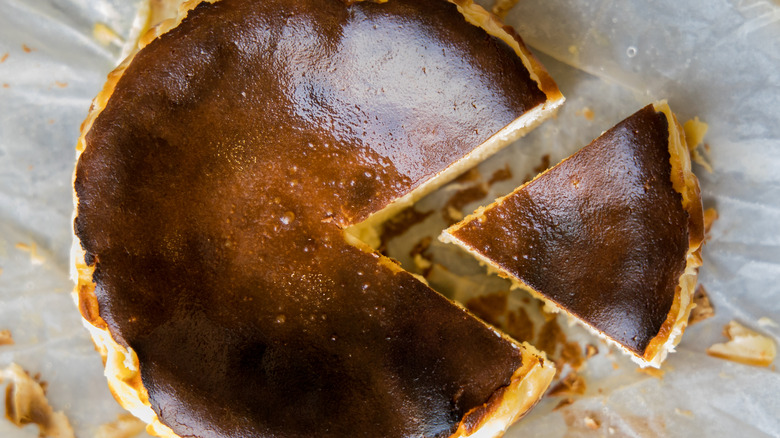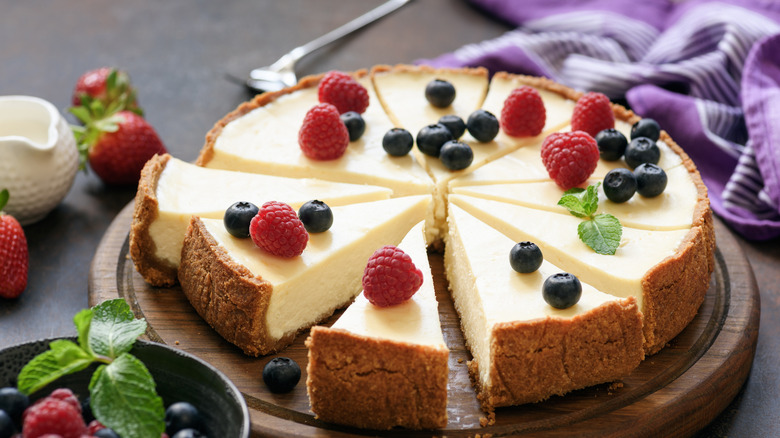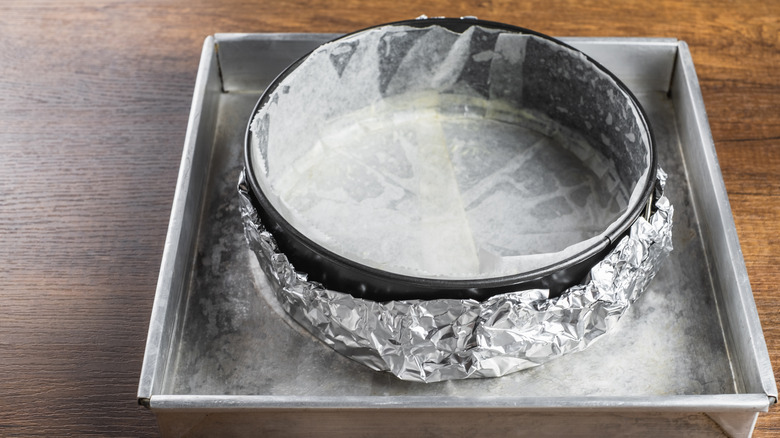Mistakes Everyone Makes With Cheesecake
There are few desserts as delicious as a classic creamy cheesecake. Whether you enjoy it rich and satisfying or light and airy, the delicate sultry taste of a slice of cheesecake is one many crave. Cheesecake comes in endless forms and flavors (as anyone who's ever visited the Cheesecake Factory can attest to this) from chocolate to fruity, it's popular for so many reasons and found on countless dessert menus.
But as enjoyable as a cheesecake can be, it's not the easiest dessert to make (though some cheesecake recipes are easier than others), and there's a lot of points along the process where things can go wrong. This may include getting too much air in the cheesecake, not cooking it at the right temperature, or for too long, and even how you remove it from the pan and what you do after.
It's quite the process before that slice of cheesecake gets on your plate, but in the end, it'll be well worth it if you get it right!
There's too much air in the cheesecake
Airy cheesecake is good, but too much air in a cheesecake can be a very bad thing, Dev Amadeo, a food blogger, told Mashed. "In my experience, one of the most common mistakes when making a cheesecake is to incorporate too much air into the mixture." Too much air will leave your cheesecake deflated like a sad balloon.
"This will make your cheesecake rise in the oven and then deflate when out, causing the surface to crack," Amadeo said. Perfect technique for flourless chocolate cake but a big NO-NO for cheesecakes. "Cheesecake is a custard-based confection after all, so incorporating air into the mixture will ruin that particular creamy luscious texture," Amadeo said.
You can prevent this by starting your recipe with room-temperature ingredients that are easy to mix, preventing you from overworking them. "You can submerge eggs in hot tap water for five minutes to bring them to room temperature and pop your cream cheese blocks in the microwave for 15 seconds at medium power level to warm them up," Amadeo said. And Amadeo always mixes in a steady slow speed just until everything is combined and there are no big lumps of cream cheese. Even a few seconds of brisk mixing can incorporate too much air.
You didn't bake the cheesecake at the right temperature
It's a big problem when you don't bake at the appropriate temperature. Again: "As a custard-based dessert, cheesecakes like to be baked in a nice warm oven, never too hot which will only cause it to curdle," Amadeo said.
For Amadeo, her cheesecake recipes always start baking in a 425°F oven and after a few minutes, she will drop it to 275°. "Total time will depend on the kind of cheesecake you are making (a thin cheesecake, cheesecake bars, mini cheesecakes) but for a full classic cheesecake you'll need to bake it for 1 hour 15 minutes," Amadeo said. You will probably find recipes out there that bake for a lesser amount of time in a hotter oven and they may be delicious, but for that particular creamy and custardy texture of a good cheesecake you need to be patient and bake at a low temperature. "I promise your reward is on the other side!" Amadeo said.
Over cooking the cheesecake
Cheesecakes should have a silky smooth mouthfeel — we are not going for quiche, here, people! Be careful when baking!
"They should wobble quite a bit in the center when they are taken out of the oven (or when the oven is turned off, depending on your baking style)," Roanna Canete, owner of San Diego's The Gluten Free Baking Company, told Mashed. They need to wobble, because they continue to cook when taken out of the heat. "It should feel almost like you touched a bowl full of jello — wobbly, but with surface tension," Canete said.
Keep in mind that wobble is different from "liquid" — you'll feel it. "Just tap it gently with a flat hand and you'll see the surface wobble," Canete said. This is the time to remove it from heat, let it rest and continue to bake. "Once it reaches room temp, it's time to refrigerate to achieve that perfect texture!" Canete said.
Rushing things so you can eat it the same day
There's nothing more devastating than trying to cut a cheesecake that is chilled on the outside and runny like pudding on the inside.
You spend so much time baking it, put in the extra overnight chill to achieve perfection! "Cheesecakes are a labor of love ... it needs part of a day to bake and cool, and then an overnight chill. You may get by with a two-hour chill time, as with this Cheesecake copycat recipe, but that's an exception. Most cheesecakes simply cannot be done all in one day, and if you are one of "those people," then compromise and make a small ramekin of cheesecake batter and bake it alongside your cake (it's going to need less baking time, so be attentive!)," Canete advised us.
That way, all you instant gratification junkies can, well, have your cake and eat it too — while your gorgeous creation chills overnight. "Cheesecakes are best started in an afternoon where you have time to be attentive, and then allow part of the evening for cooling, and then chill overnight," Canete said.
Taking the cheesecake out of the pan while still warm
Yes, it's tempting to grab a slice of that cheesecake as soon as it's done cooking, but it's not yet ready to be enjoyed. Patience will lead to better results!
Canete told Mashed: "The edge of your glorious cheesecake (arguably the best part) will stick to the sides of the springform if not properly chilled before trying to remove the pan." So what do you do? Plan ahead to let that baby chill overnight! "When you're ready to remove it, if it seems stuck, you can run a knife or offset spatula around the edge of the pan, but a properly chilled cheesecake should pop right out of the pan," Canete said.
So if you are having a special dinner party tomorrow night and want to serve your famous cheesecake, it'll probably be in your best interest to make that cheesecake the night before. You want to make sure it has time to rest, chill, and be removed from the pan before the main event!
You made the cheesecake with gluten
Everyone wants to wow their gluten-free friends with a snazzy dessert that gluten lovers and haters will both love. So, so if you want to give a sans gluten cheesecake a spin, look for a cheesecake recipe that does not call for flour. While some cheesecake recipes contain flour (which has gluten), others don't — so making a gluten-free cheesecake is often as easy as just omitting that one ingredient. (On a keto-free diet? Don't worry, you can still have your no-bake keto cheesecake.)
Then, simply make your crust with gluten-free graham crackers or GF vanilla cookies — or even GF Oreos — following the usual graham cracker crust instructions. "Your gluten-free friends will feel so cared for, and you'll never let on how easy it was!" baker and cafe owner Roanna Canete, advised us. Just bask in the praise and throw out phrases like: "It was hard work but I did it for you!" Hey, the cheesecake is already sinful enough, what's a little white lie added in?
You used the wrong pan for the cheesecake
This might be an unpopular suggestion but ... you don't always need to use a springform pan. In fact, you may get surprisingly great results if you don't. Think out of the box! Err, pan.
"I like to bake cheesecakes in a water bath, but springform pans oftentimes leak and take on water even when they're wrapped well," Pastry Chef Ann Kirk of Little Dom's in Los Angeles and Little Dom's Seafood Carpinteria, California, told Mashed.
Nobody likes the heartbreak of a soggy cheesecake. "I use a regular old cake pan instead," Kirk said. This tip is a great one as a regular old cake pan is probably already sitting in your pantry. It has a great added benefit, though. "Unmolding is easy if you invert it onto a large plate or cake board and warm the outside of the pan with a torch. It releases with ease. I've been doing it this way for years!" Kirk said.
Your cheesecake is too soft/runny in the center
It can be difficult to judge when a cheesecake is completely baked. "I generally look for the edges to be set and for the center 2 inches or so to have just a bit of a jiggle," Jenni Field of Pastry Chef Online, shared with Mashed.
But that's a very subjective way of checking doneness, especially if you are only an occasional cheesecake baker. To be sure, take the temperature in the center of the cheesecake. "You are looking for a temperature of 150-155°F when it comes out of the oven," Field said. "With carryover cooking, you'll end up between 155-160°F. This is the temperature at which eggs are fully cooked, and since eggs are what allow your cheesecake to set, you'll know you won't end up with a runny surprise when you cut your cheesecake."
And of course, allow your cheesecake to cool for a couple of hours and then chill it thoroughly in the fridge before slicing and serving. "For the creamiest texture, allow the slices to sit out for about 30 minutes before serving," Field said.
The cheesecake has cracks
The dreaded cracking is a common cheesecake issue, and it can happen for a couple of reasons. "The first is that you beat the cheesecake batter on too high a speed, incorporating a lot of air. When all that trapped air hits the hot oven, it expands, causing your cheesecake to rise up like a souffle and then settle once out of the oven," Field told us. If it settles unevenly, which is highly likely, you get cracking.
Always make sure your cream cheese is very soft and that all your ingredients, including eggs, cream, sour cream, etc. are at room temperature. "Beat the cream cheese first on low speed until it is smooth and creamy," Field said.
Make sure it's completely smooth. Now is the time to get any lumps out, because you are out of luck once you start adding other ingredients. Add the rest of the ingredients and beat in on low to medium-low speed just until combined. No need to use high or even medium speed. This will minimize the amount of air and also the "souffle-ing."
Your cheesecake got too hot
Another reason your cheesecake can crack is baking at too high a temperature. "Cheesecake is a custard, and as such, it requires a gentle heat to bake up smooth and creamy with a lovely flat top," Field told Mashed.
"Even baking at a "normal" cake baking temperature of 350°F is too hot, especially with a cheesecake that only has a bottom crust rather than one that comes all the way up the sides of the pan," Field said.
Especially without a crust, cheesecake will bake faster at the edges of the pan, leaving cracks and a crater in the center. "You can always use that to your advantage by filling it with delicious topping, but a better fix is to bake in a water bath or to make sure your crust comes all the way up the sides of the pan, acting as an insulator for the delicate cheesecake batter," Field added.
You didn't do a water bath for the cheesecake
It probably sounds tempting to skip this crucial step for the sake of a shortcut, but your cheesecake deserves a warm bath. "This is key for the cheesecake to bake evenly, preventing dry and chewy edges or burnt spots on top," food blogger Dev Amadeo told Mashed.
If using a springform pan (you can use a deep pie dish as well) just wrap it around in paper foil almost to the top to prevent the water from slipping into the pan and ruining the crust. "I like to use my deepest baking sheet and fill it with water more than halfway through to make sure there's water during the whole baking time," Amadeo said.
To make a water bath, Jenni Field of Pastry Chef Online, told Mashed: Place a pan large enough to hold your cheesecake pan with at least 1" all around the sides. Wrap your cheesecake pan with a double layer of heavy-duty foil, fill the pan with batter and set it inside the larger pan. Carefully fill the larger pan with boiling water so it comes at least halfway up the sides of your springform pan. Why it works: "As long as there is water in the water bath, the sides of the pan will never get above 212°F, or the boiling point of water (at sea level). This allows even the edges of your cheesecake to bake slowly in a steamy environment," Field explained.
